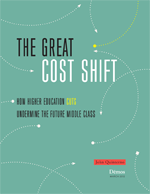Summary
This report examines how state disinvestment in public higher education over the past two decades has shifted costs to students and their families. Such disinvestment has occurred alongside rapidly rising enrollments and demographic shifts that are yielding more economically, racially, and ethnically diverse student bodies. As a result students and their families now pay—or borrow—a lot more for a college degree or are getting priced out of an education that has become a requirement for getting a decent job and entering the middle class.
This study traces trends in the size and composition of the young adult population and analyzes patterns in state support for public higher education over the past two decades. Trends in tuition and financial aid are also examined and policy recommendations are presented for ways to renew America’s commitment to nurturing a strong and inclusive middle class through investments in public higher education.
Key highlights of the report include:
College Population Trends
- Compared to the generation that came of age in the 1990s, the current population of young adults is much larger in size, much more racially and ethnically diverse, and more apt to enroll in college than the generation that came of age in the 1990s.
- Public institutions have played an important role in serving the growing numbers of undergraduate students. Public institutions absorbed 65.6 percent of the undergraduate enrollment increases that have occurred since 1990.
State Investment in Higher Education
- A review of financial data from 1990 onwards suggests that a structural change in state support for higher education is underway.
- While state spending on higher education increased by $10.5 billion in absolute terms from 1990 to 2010, in relative terms, state funding for higher education declined. Real funding per public full-time equivalent student dropped by 26.1 percent from 1990-1991 to 2009-2010.
- Over the past 20 years there has been a breakdown in the historical funding pattern of recessionary cuts and expansionary rebounds. The length of time for higher education funding to recover following recessions has lengthened for every downturn since 1979 with early evidence suggesting that the recovery from the Great Recession will be no different.
Patterns in Tuition and Financial Aid
- As state support has declined, institutions have balanced the funding equation by charging students more. Between 1990-1991 and 2009-2010, published prices for tuition and fees at public four-year universities more than doubled, rising by 116 percent, after adjusting for inflation, while the real price of two-year colleges climbed by 71 percent.
- In many states, the tuition increases of the past 20 years have occurred alongside expansions in state-sponsored financial aid programs. However, an increasing percentage of that aid is taking the form of merit-based aid which is awarded without regard for students’ financial situations.
Challenges for Students, Families, and States
- The steady escalation in college prices has occurred alongside stagnant incomes for most American households. Median household income in the United States in 2010 was just 2.1 percent higher than in 1990.
- To bridge the gap between cost and financial aid, increasingly students are borrowing from federal loan programs and private sources like banks. The volume of outstanding student loan debt has grown by a factor of 4.5 since 1999.
